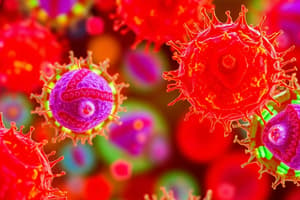Podcast
Questions and Answers
What is the primary outcome of mitosis?
What is the primary outcome of mitosis?
- Sister chromatids remain together
- Two identical daughter cells are formed (correct)
- One parent cell divides into four gametes
- Chromosome number is halved
Which phase of mitosis involves chromosomes aligning in the center of the cell?
Which phase of mitosis involves chromosomes aligning in the center of the cell?
- Anaphase
- Metaphase (correct)
- Prophase
- Telophase
In cellular respiration, where does the Krebs Cycle occur?
In cellular respiration, where does the Krebs Cycle occur?
- In the nuclear envelope
- In the cytoplasm
- In the mitochondria (correct)
- Across the cell membrane
What is the function of catabolism in cellular metabolism?
What is the function of catabolism in cellular metabolism?
Which type of cell signaling relies on hormones binding to specific receptors?
Which type of cell signaling relies on hormones binding to specific receptors?
What is the first stage of cellular respiration?
What is the first stage of cellular respiration?
What happens during the anaphase stage of mitosis?
What happens during the anaphase stage of mitosis?
Which process is involved in synthesizing complex molecules from simpler ones?
Which process is involved in synthesizing complex molecules from simpler ones?
What is a primary characteristic of prokaryotic cells?
What is a primary characteristic of prokaryotic cells?
Which organelle is known as the powerhouse of the cell?
Which organelle is known as the powerhouse of the cell?
What is the primary function of the cell wall in prokaryotic cells?
What is the primary function of the cell wall in prokaryotic cells?
What is a key feature of eukaryotic cells that distinguishes them from prokaryotic cells?
What is a key feature of eukaryotic cells that distinguishes them from prokaryotic cells?
Which type of endoplasmic reticulum is involved in protein synthesis?
Which type of endoplasmic reticulum is involved in protein synthesis?
What is the primary role of lysosomes in a cell?
What is the primary role of lysosomes in a cell?
What composes the cell membrane structure?
What composes the cell membrane structure?
Which of the following is NOT a characteristic of eukaryotic cells?
Which of the following is NOT a characteristic of eukaryotic cells?
Flashcards are hidden until you start studying
Study Notes
Cell Biology
Basic Unit of Life
- Cells are the fundamental building blocks of all living organisms.
- Two primary types of cells: prokaryotic (without nucleus) and eukaryotic (with nucleus).
Prokaryotic Cells
- Characteristics:
- Lack a defined nucleus; genetic material is in a nucleoid.
- Usually smaller and simpler than eukaryotic cells.
- Example: Bacteria and Archaea.
- Structure:
- Plasma membrane: controls movement of substances in and out.
- Cell wall: provides structure and protection.
- Ribosomes: synthesize proteins.
- Plasmids: small DNA molecules that are separate from chromosomal DNA.
Eukaryotic Cells
- Characteristics:
- Have a defined nucleus that contains genetic material.
- More complex than prokaryotic cells.
- Examples: Plant cells, animal cells, fungi, and protists.
- Structure:
- Plasma membrane: similar function as in prokaryotes, but more complex.
- Organelles: specialized structures with specific functions (e.g., mitochondria, endoplasmic reticulum).
- Cytoplasm: jelly-like substance where organelles are suspended.
Key Organelles
- Nucleus:
- Contains DNA; responsible for genetic control.
- Mitochondria:
- Powerhouse of the cell; site of ATP (energy) production.
- Ribosomes:
- Sites of protein synthesis; can be free-floating or attached to the endoplasmic reticulum.
- Endoplasmic Reticulum (ER):
- Rough ER: studded with ribosomes; involved in protein synthesis and processing.
- Smooth ER: involved in lipid synthesis and detoxification.
- Golgi Apparatus:
- Modifies, sorts, and packages proteins and lipids for secretion or use within the cell.
- Lysosomes:
- Contain digestive enzymes to break down waste materials and cellular debris.
Cell Membrane
- Structure:
- Composed of a lipid bilayer with embedded proteins.
- Functions:
- Regulates entry and exit of substances.
- Provides protection and support.
- Facilitates cell communication through signaling molecules.
Cell Division
- Types:
- Mitosis: process of cell division resulting in two identical daughter cells; important for growth and repair.
- Meiosis: specialized form of cell division that produces gametes (sex cells); reduces chromosome number by half.
- Phases of Mitosis:
- Prophase: chromatin condenses into chromosomes; nuclear envelope breaks down.
- Metaphase: chromosomes align in the center of the cell.
- Anaphase: sister chromatids are pulled apart to opposite poles.
- Telophase: nuclear envelopes reform; chromosomes de-condense.
Cellular Metabolism
- The sum of all chemical reactions in a cell, including:
- Catabolism: breakdown of molecules to obtain energy.
- Anabolism: synthesis of complex molecules from simpler ones, requiring energy.
Cell Communication
- Mechanisms include:
- Hormonal signaling: hormones bind to specific receptors on target cells.
- Neurotransmission: release of neurotransmitters across synapses between neurons.
- Direct contact signaling: cell junctions allow communication between neighboring cells.
Cellular Respiration
- Process by which cells convert glucose and oxygen into energy (ATP), carbon dioxide, and water.
- Stages:
- Glycolysis: occurs in the cytoplasm; breaks down glucose into pyruvate.
- Krebs Cycle: occurs in mitochondria; processes pyruvate to produce electron carriers.
- Electron Transport Chain: occurs in mitochondrial membrane; produces ATP using energy from electron carriers.
These notes cover the foundational concepts of cell biology essential for understanding the structure and function of cells in living organisms.
Basic Unit of Life
- Cells are the fundamental units of life, forming all organisms.
- Two primary types of cells: prokaryotic (no nucleus) and eukaryotic (nucleus present).
Prokaryotic Cells
- Characteristics include no defined nucleus; genetic material is located in a nucleoid.
- Generally smaller and simpler compared to eukaryotic cells.
- Examples are Bacteria and Archaea.
- Key structures:
- Plasma membrane regulates substance movement.
- Cell wall provides structural support and protection.
- Ribosomes are responsible for protein synthesis.
- Plasmids are small, circular DNA molecules independent from chromosomal DNA.
Eukaryotic Cells
- Defined by the presence of a nucleus that houses genetic material.
- More complex than prokaryotic cells, with examples including plant cells, animal cells, fungi, and protists.
- Key structures:
- Plasma membrane has complex functions in substance regulation.
- Organelles perform specific tasks (e.g., mitochondria for energy production).
- Cytoplasm is a jelly-like matrix where organelles are suspended.
Key Organelles
- Nucleus: Contains DNA; central to genetic regulation.
- Mitochondria: Known as the powerhouse of the cell; site for ATP production.
- Ribosomes: Protein synthesis sites, can be free or attached to the endoplasmic reticulum.
- Endoplasmic Reticulum (ER):
- Rough ER: Studded with ribosomes for protein synthesis and processing.
- Smooth ER: Involved in lipid synthesis and detoxification processes.
- Golgi Apparatus: Modifies, sorts, and packages proteins and lipids for transport.
- Lysosomes: Digestive organelles containing enzymes for breaking down waste.
Cell Membrane
- Composed of a lipid bilayer with integrated proteins.
- Functions include regulating substances entering and exiting the cell, providing structural support, and facilitating cell signaling.
Cell Division
- Mitosis produces two identical daughter cells for growth and repair.
- Meiosis generates gametes (sex cells) with half the chromosome number.
- Phases of Mitosis:
- Prophase: Chromatin condenses into chromosomes; nuclear envelope disintegrates.
- Metaphase: Chromosomes align at the cell's center.
- Anaphase: Sister chromatids are separated to opposite poles.
- Telophase: Nuclear envelopes reform and chromosomes de-condense.
Cellular Metabolism
- Encompasses all chemical reactions within a cell:
- Catabolism involves breaking down molecules for energy.
- Anabolism refers to synthesizing complex molecules, requiring energy input.
Cell Communication
- Hormonal signaling involves hormone binding to target cell receptors.
- Neurotransmission occurs via neurotransmitter release across synapses.
- Direct contact signaling utilizes cell junctions for communication between adjacent cells.
Cellular Respiration
- Cells convert glucose and oxygen into ATP, carbon dioxide, and water.
- Stages include:
- Glycolysis: Breaks down glucose in the cytoplasm into pyruvate.
- Krebs Cycle: Occurs in mitochondria, processes pyruvate to produce electron carriers.
- Electron Transport Chain: Takes place in mitochondrial membranes, generating ATP using energy from electron carriers.
Studying That Suits You
Use AI to generate personalized quizzes and flashcards to suit your learning preferences.




